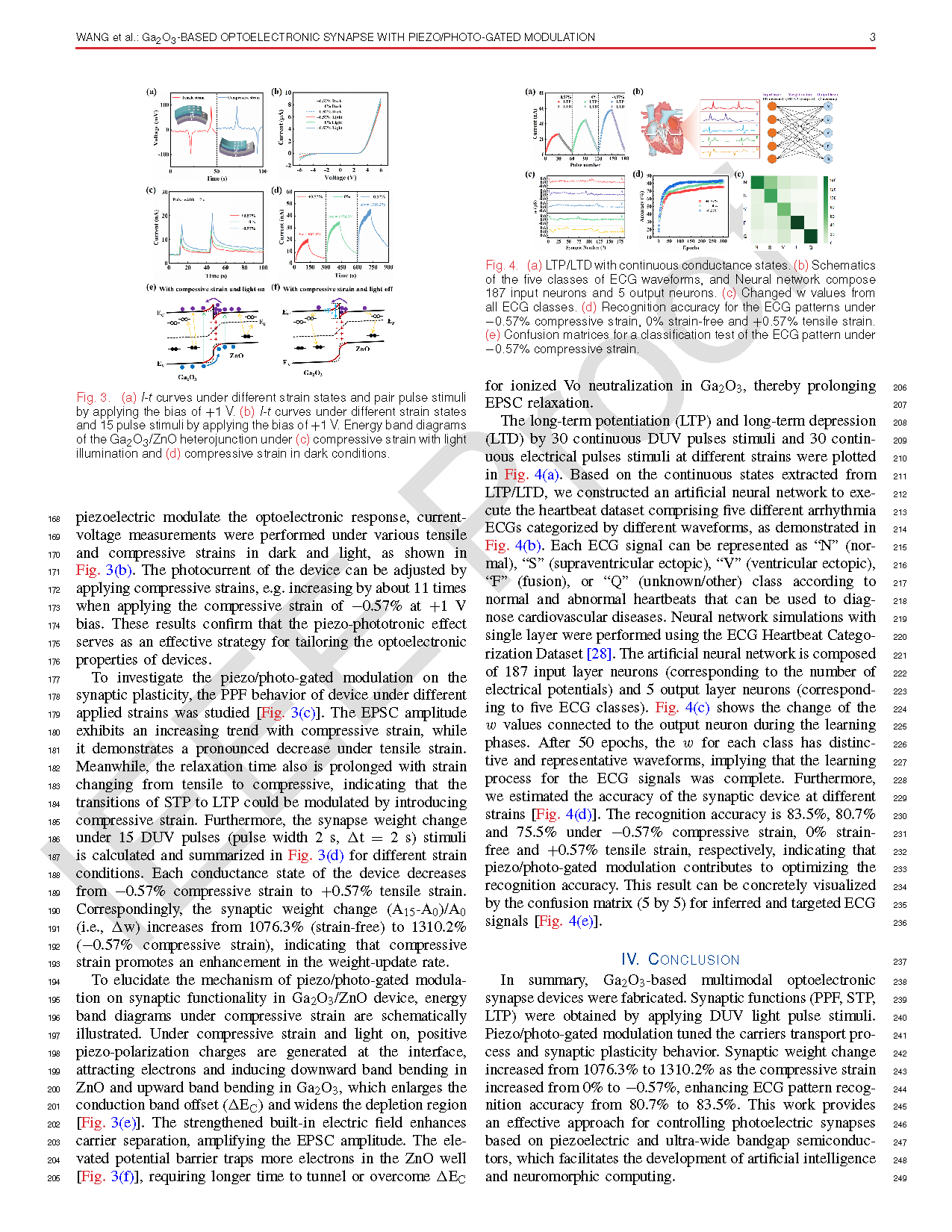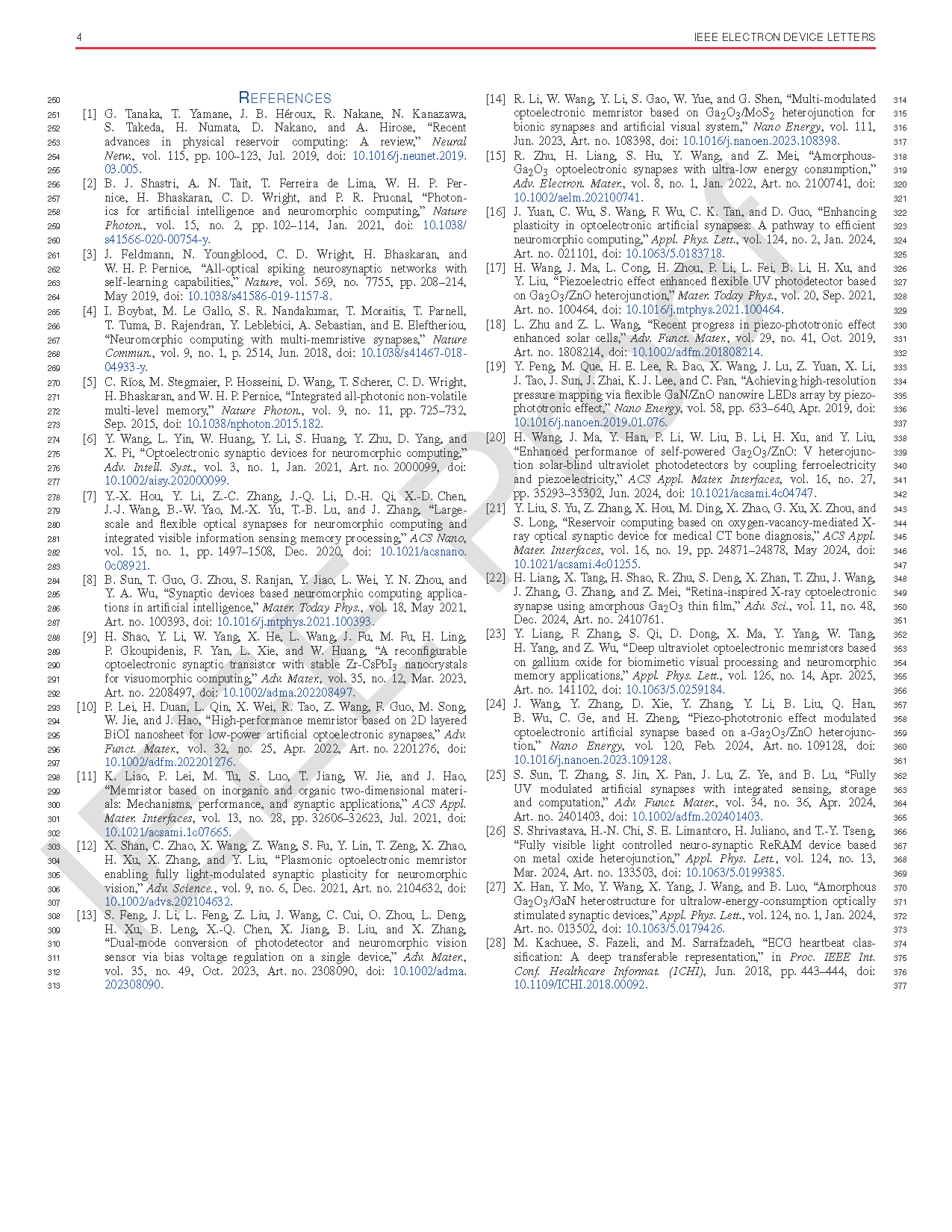

【Member Papers】Ga₂O₃-based optoelectronic synapse with piezo/photo-gated modulation for multimodal perception
日期:2025-08-06阅读:295
Researchers from the Northeast Normal University have published a dissertation titled "Ga2O3-based optoelectronic synapse with piezo/photo-gated modulation for multimodal perception" in IEEE Electron Device Letters.
Project Support
This work was supported in part by the National Key Technologies Research and Development Program of China under Grant 2021YFA0716404, in part by the National Natural Science Foundation of China under Grant 12474164 and Grant 62404038, in part by the Postdoctoral Fellowship Program of CPSF under Grant GZC20240240, in part by the Fundamental Research Funds for the Central Universities under Grant 2412024QD009 and Grant 2412023QD004, and in part by the Research Projects of the Education Office of Jilin Province under Grant JJKH20250300KJ.
Background
In the digital era, emerging technogies like 5G, arti ficial intelligence (AI), Internet of Things (IoT), and big data pose unprecedented challenges to data processing and storage. The limitations of von Neumann architectures in real-time massive data processing have spurred interest in neuromorphic computing which mimics brain-like parallel computation with high efficiency and low power consumption. Synaptic devices, as fundamental units of neuromorphic systems are being revolutionized by optoelectronic synapses that combine optical/electronic modulation for bio-inspired vision systems. These photoelectric devices offer ultrafast speed and broad bandwidth. Recent material explorations include perovskites, 2D materials, organic materials, oxides. Particularly, oxide semiconductors with oxygen vacancies (Vo) show promise, where Vo-induced persistent photoconductivity (PPC) is considered crucial for synaptic functions.
Abstract
Ga2O3 leverage high deep-ultraviolet (DUV) responsivity and persistent photoconductivity (PPC) to enable low-power synaptic devices. However, limited PPC relaxation controllability in existing Ga2O3 synapses restricts tunable plasticity. This work demonstrates a piezo/photo-gated modulated Ga2O3/ZnO synaptic device for multimodal perception. The device exhibits reconfigurable synaptic plasticity—including paired-pulse facilitation, short-to-long-term plasticity transition, and dynamic weight modulation — under 254 nm light pulses. Crucially, compressive strain (−0.57%) enhances synaptic weight change by 22% (from 1076.3% to 1310.2%), attributed to strain-induced band bending at the heterojunction interface that regulates carrier separation and oxygen vacancy recombination. This strain-modulated behavior enables intelligent health care to the human body, where electrocardiogram pattern recognition achieves 83.5% accuracy using a single-layer neural network. This study establishes a viable approach for developing functionally tunable photoelectric synapses with co-integrated sensing-memory-processing capabilities for artificial tactile-perception systems.

Fig. 1. (a) Schematic diagram of Ga2O3/ZnO synaptic device. (b) Cross-sectional SEM image of Ga2O3/ZnO/ITO films. (c) XRD patterns of Ga2O3/ZnO/ITO films. (d) Absorption curves and corresponding bandgaps of Ga2O3 and ZnO films. The O 1s XPS spectrum of (e) Ga2O3 and (f) ZnO films.

Fig. 2. (a) I-t curves under different strain states and pair pulse stimuli by applying the bias of +1 V. (b) I-t curves under different strain states and 15 pulse stimuli by applying the bias of +1 V. Energy band diagrams of the Ga2O3 /ZnO heterojunction under (c) compressive strain with light illumination and (d) compressive strain in dark conditions.
DOI:
doi.org/10.1109/LED.2025.3590716






